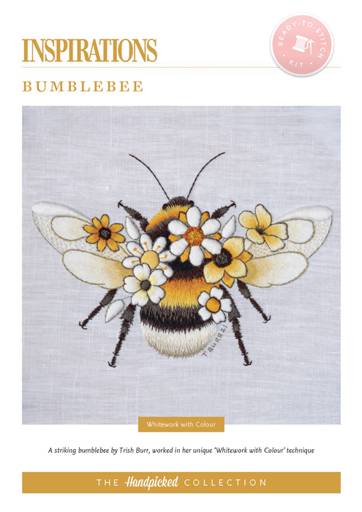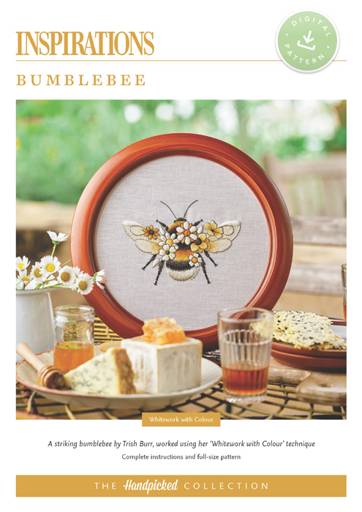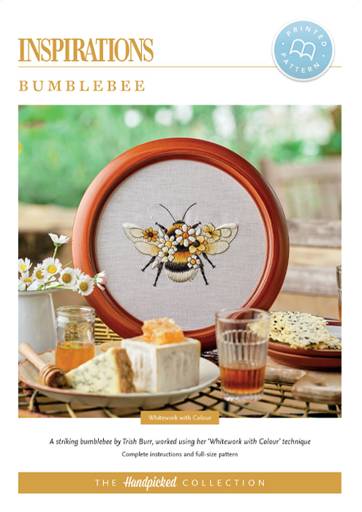Bumblebee by Trish Burr
16TH SEPTEMBER 2022 - ASU #348
The humble bee… how did it become one of the most popular and famous insects of all time?

Having now expanded their brand presence far beyond just the garden, imagery of bees, honey and anything to do with the business of pollination can be found on almost anything and anywhere.
Whichever marketing company the bees engaged to represent them should take a bow – they have done an amazing job of marketing and promoting these busy buzzy fellows.

Bees can now be found starring in movie roles, appearing on merchandise, homewares products, clothing, stationery lines, featuring in embroidery designs, sung about in pop songs, they also lay claim to the second letter of the alphabet… let’s face it the bee is probably more famous than even Elvis!
Trish Burr is also quite famous – creating a new trend in needlework called whitework with colour is just one of her many claims to fame.
By designing a series of projects entitled ‘Shades of Whitework’ Trish introduced colour into what were predominantly monochromatic pieces and in doing so revolutionised a technique that had previously been limited to a singular colour – white.

It is by using the whitework with colour process that Trish has created the ridiculously charming project Bumblebee that has been released as part of our Handpicked series – projects that you can purchase exclusively as printed or digital patterns.
Now, back to the bee. In particular, the bumblebee. Let’s look at some facts. The bumblebee is part of the larger bee family and is identified by its big, fluffy abdomen, a clue as to why they are so popular – fluffy always equals cute, right? Maybe not when it comes to spiders though… but we digress.

Feeding on nectar and living in small colonies, bumblebees are as important as pollinators as honeybees but are equally endangered.
When seeking to be both popular and famous, it also helps to have an incredibly important job that everyone benefits from. Honeybees alone pollinate 80 percent of all flowering plants, including more than 130 types of fruits and vegetables. So whether it’s enjoying a healthy bite to eat or a vase of fresh flowers in your home, bees are right up there in delivering the goods for us all.

Taking a closer look at the Bumblebee piece Trish has created, we can see why Trish Burr is also so famous.
Trish is very clever in both her composition and application of techniques.
The bee’s large fluffy body has been skilfully shaped using long and short stitch combined with subtle shading across the iconic black stripes.
Cute, stumpy legs, stitched again with short and long stitch, help to replicate the anatomically correct nature of their hairy legs.

Next, we have two sets of wings finished in a wonderful combination of techniques. Padded satin stitch on the front edges to create height, seed stitch for texture and threadpainting to replicate transparency.
The entire piece is worked with stranded cotton onto white linen, and to elevate the design further, Trish adorns our famous friend with a sprinkling of flowers as a subtle reminder of the unique symbiotic relationship they share.

For those of us who can’t wait to thread up our needles and begin stitching this fabulous piece, the Bumblebee Ready-to-Stitch kit even comes with the design pre-printed on the fabric so you can skip the design transfer process and lay your first stitches the minute you’ve hooped up.
There we have it, another classic Trish Burr design for us all to enjoy stitching and another reason why both Trish and bees are so famous!
Make Your Own Bumblebee

Step 1 – Purchase Project Instructions
Bumblebee by Trish Burr is a striking bumblebee, worked in Trish’s unique ‘Whitework with Colour’ technique.
Step 2 – Purchase Ready-To-Stitch Kit
The Inspirations Ready-To-Stitch kit for Bumblebee includes everything* you need to re-create this this spectacular specimen: Fabric (with pre-printed design), embroidery threads and needles.

Kit
Bumblebee - HP Kit
Shop Now*Please Note: To cater for flexibility of purchase, instructions are not included with our kits. For step-by-step directions on how to create this project, please refer to the printed/digital pattern.


